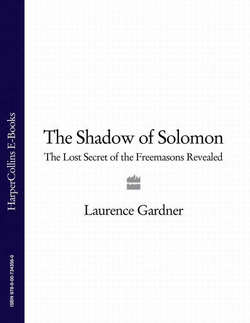Читать книгу The Shadow of Solomon: The Lost Secret of the Freemasons Revealed - Laurence Gardner - Страница 12
2 Masonic Origins Secret Signs
ОглавлениеMasons, in the operative sense, are stoneworkers, but the term Freemason is not so readily understandable. Many views have been put forward as to what the word actually means, but even Freemasons tend to disagree. The best routes to the origin of words are good etymological dictionaries—these have no vested interest and do not need to slant their descriptions in any particular way. The most famous of such early works is the 1721 edition of Nathan Bailey’s Universal Etymological Dictionary. This was published just two years before James Anderson’s Constitutions and, interestingly, the word Freemason does not appear. Neither does it in the revised edition of 1736.
Writers such as John Hamill (librarian and curator for the United Grand Lodge of England in 1986) consider that ‘freemason’ is a contraction of ‘freestone mason’—a worker in finely grained freestones such as limestone and sandstone, which have no flaws and are easily cut.1 Although quite plausible, this is not in keeping with general masonic theory which suggests that the prefix ‘free-’ relates to the realm of the ‘speculative’ rather than ‘operative’—ie, not a working stonemason as such. However, the term ‘freestone mason’ is recorded as far back as 1375, while the epitaph of a freestone quarryman at St Giles Church, Sidbury, describes him as ‘John Stone, free mason’. It is thought that he was the father of the celebrated sculptor Nicholas Stone, who became Master of Works in 1619 for the great architect Inigo Jones at London’s Banqueting House in Whitehall. Among the noted achievements of Devonshire-born Nicholas Stone (1586-1647) is the gate at St Mary’s Hall, Oxford, the monument to the poet John Donne at St Paul’s Cathedral, and numerous tombs including that of Viscount Dorchester at Westminster Abbey. In 1625, he was appointed as Master Mason at Windsor Palace by King Charles I.
When entitling his Constitutions, James Anderson hyphenated the word as ‘Free-Masons’ and, in earlier times, two separate words were sometimes used—which may explain the non-existence of ‘freemason’ in old dictionaries. Another early use of the term comes from 1435, when ‘John Wode, mason, contracts to build the tower of the Abbey of St Edmundsbury in all manner of things that longe to free masonry’.2 In line with this, the Oxford Word Library explains that, in those times, stonemasons’ guilds would emancipate (or free) their local members so that they might travel from place to place in order to gain work contracts. When arriving in unfamiliar surroundings, they would communicate their degrees of proficiency by way of secret signs known only to others of their craft.
This makes reasonable sense and certainly gives a valid reason for the use of signs and passwords in order to gain employment at the right level of attainment. However, latter-day Freemasons are, for the most part anyway, not operative stonemasons and do not require the signs for this purpose. Either way, it is clear that by the mid-1600s operative masonic guilds did afford membership to non-operatives3 (for example, selected employers, who would need to know the signs and symbols when hiring their workmen). Thus, as is commonly believed in masonic circles, the structural framework of Freemasonry (even if not the inherent subject matter) does seem to emanate from the methods employed by the medieval workers’ guilds.
